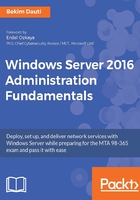
上QQ阅读APP看书,第一时间看更新
Summary
We summarize the chapter with following points:
- A computer network is a group of computers connected to each other in order to share resources.
- The components of a computer network are the substance that constitutes the computer network.
- A host is any device that offers networking resources to any other nodes and users on the network.
- A node is any device that can generate, receive, and transmit the networking resources on the computer network.
- A client is a computer that requests the resources in a computer network.
- A server is a network component that provides resources to the clients.
- Peer-to-peer (P2P) networking is a computer network in which the participating computers do not have predefined roles in the network.
- Client/server networking is a computer network in which participating computers have predefined roles in the network.
- NOS is software that provides, manages, and maintains resources on the network.
- Computer hardware is any physical component regardless of the material that it is made of, such as metal, plastic, or wood.
- The software is an instruction or the program that tells the hardware what to do.
- A processor is a chip on a server's motherboard, often called the computer's brain, that does all the processing and calculations.
- RAM is the working memory used by your server's OS and applications.
- A disk is a storage where your servers are storing data.
- A network interface provides a network connection to and out of your servers.
- Rack-mountable servers are big servers that are mounted on a rack.
- Blade servers are small modules known as blades that are mounted on a server's chassis to save space.
- Tower servers are single servers that stand upright.
- The Start menu is returned in Windows Server 2016.
- The TechNet Evaluation Center is a web portal that provides the option to download and evaluate Microsoft's products free of cost.
- The Windows Server 2016 Datacenter is designed for enterprises that own highly virtualized data centers or act as cloud providers.
- Windows Server 2016 Standard is designed for medium-sized businesses that use servers on-premises to run their network services.
- Windows Server 2016 Essentials is designed for small businesses that run a single server in their IT infrastructure.